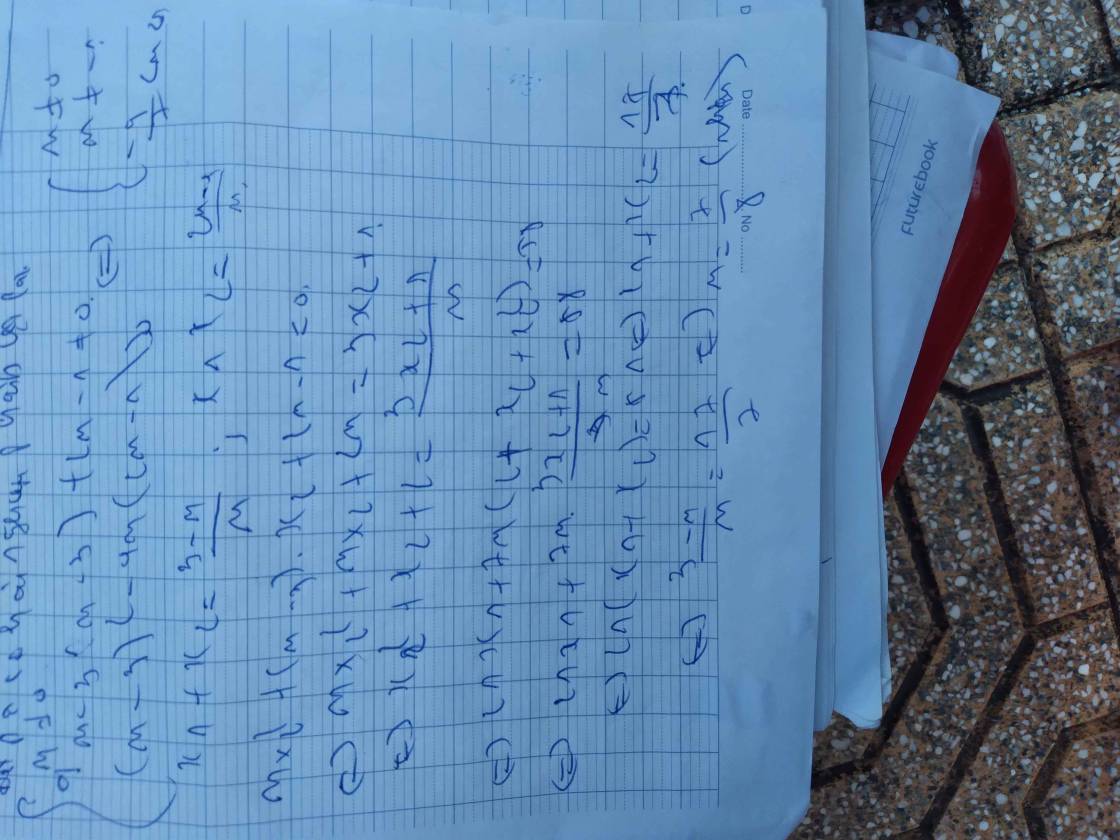Hãy nhập câu hỏi của bạn vào đây, nếu là tài khoản VIP, bạn sẽ được ưu tiên trả lời.

b: x1=3x2 và x1+x2=2m-2
=>3x2+x2=2m-2 và x1=3x2
=>x2=0,5m-0,5 và x1=1,5m-1,5
x1*x2=-2m
=>-2m=(0,5m-0,5)(1,5m-1,5)
=>-2m=0,75(m^2-2m+1)
=>0,75m^2-1,5m+0,75+2m=0
=>\(m\in\varnothing\)
c: x1/x2=3
x1+x2=2m-2
=>x1=3x2 và x1+x2=2m-2
Cái này tương tự câu b nên kết quả vẫn là ko có m thỏa mãn

Lời giải:
a) Khi $m=2$ thì pt trở thành:
$x^2-10x+15=0\Leftrightarrow (x-5)^2=10\Rightarrow x=5\pm \sqrt{10}$
b)
Để pt có 2 nghiệm pb $x_1,x_2$ thì trước tiên:
$\Delta'=(2m+1)^2-(4m^2-2m+3)>0$
$\Leftrightarrow 6m-2>0\Leftrightarrow m>\frac{1}{3}$
Áp dụng định lý Viet: \(\left\{\begin{matrix} x_1+x_2=2(2m+1)\\ x_1x_2=4m^2-2m+3\end{matrix}\right.\)
Để $(x_1-1)^2+(x_2-1)^2+2(x_1+x_2-x_1x_2)=18$
$\Leftrightarrow x_1^2+x_2^2-2(x_1+x_2)+2+2(x_1+x_2-x_1x_2)=18$
$\Leftrightarrow x_1^2+x_2^2-2x_1x_2=16$
$\Leftrightarrow (x_1+x_2)^2-4x_1x_2=16$
$\Leftrightarrow 4(2m+1)^2-4(4m^2-2m+3)=16$
$\Leftrightarrow (2m+1)^2-(4m^2-2m+3)=4$
$\Leftrightarrow 6m-2=4\Leftrightarrow m=1$ (thỏa mãn)
vậy...........


Xét phương trình: \(x^2-2\left(m+3\right)x+2m+5=0\Rightarrow\Delta'=\left(m+3\right)^2-2m-5=\left(m+2\right)^2\ge0\) .
Do đó phương trình luôn có 2 nghiệm và để phương trình có 2 nghiệm phân biệt thì \(m\ne-2.\)
Theo định lý viet thì ta có: \(\hept{\begin{cases}x_1+x_2=2m+6\\x_1x_2=2m+5\end{cases}}\). Do đó: \(m>-\frac{5}{2}\)\(\frac{1}{\sqrt{x_1}}+\frac{1}{\sqrt{x_2}}=\frac{4}{3}\Rightarrow\frac{1}{x_1}+\frac{1}{x_2}+2\sqrt{\frac{1}{x_1x_2}}=\frac{x_1+x_2}{x_1x_2}+2\sqrt{\frac{1}{2m+5}}=\frac{16}{9}\)
\(\Leftrightarrow\frac{2m+6}{2m+5}+2\sqrt{\frac{1}{2m+5}}=\frac{1}{2m+5}+2\sqrt{\frac{1}{2m+5}}+1=\left(\sqrt{\frac{1}{2m+5}}+1\right)^2=\frac{16}{9}\)
\(\Rightarrow\sqrt{\frac{1}{2m+5}}=\frac{1}{3}\Leftrightarrow\frac{1}{2m+5}=\frac{1}{9}\Leftrightarrow2m+5=9\Leftrightarrow m=2.\)
Vậy \(m=2.\)

cho pt: x2 + 4(m - 1)x-12=0 (1)
tìm m để pt (1) có 2no phân biệt x1,x2 thỏa mãn: |x1 - 2| . √4-mx2 = 4

Δ=(-2)^2-4(m-3)
=4-4m+12=16-4m
Để phương trình có hai nghiệm dương phân biệt thì 16-4m>0 và m-3>0
=>m>3 và m<4
x1^2+x2^2=(x1+x2)^2-2x1x2
=2^2-2(m-3)=4-2m+6=10-2m
=>x1^2=10-2m-x2^2
x1^2+12=2x2-x1x2
=>10-2m-x2^2+12=2x2-m+3
=>\(-x_2^2+22-2m-2x_2+m-3=0\)
=>\(-x_2^2-2x_2-m+19=0\)
=>\(x_2^2+2x_2+m-19=0\)(1)
Để (1) có nghiệmthì 2^2-4(m-19)>0
=>4-4m+76>0
=>80-4m>0
=>m<20
=>3<m<4

a: Để phương trình có hai nghiệm trái dấu thì
m^2+2m+3<0
=>m^2+2m+1+2<0
=>(m+1)^2+2<0(vô lý)
b:
Δ=(2m+3)^2-4(m^2+2m+3)
=4m^2+12m+9-4m^2-8m-12
=4m-3
Để phương trình có hai nghiệm phân biệt thì 4m-3>0
=>m>3/4
4x1x2=(x1+x2)^2-2(x1+x2)+5
=>4*(m^2+2m+3)=(2m+3)^2-2(2m+3)+5
=>4m^2+8m+12=4m^2+12m+9-4m-6+5
=>8m+12=8m-1
=>12=-1(vô lý)